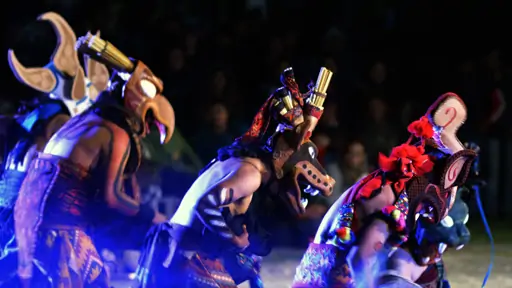Indigenous Calendar January, 2015: Re-enacting a Kaqchikel Maya Ritual

Every society — past and present — has established its rituals. We might no longer think of ours in the modern world as rituals, but whether it's a wedding, a housewarming or dressing up on Halloween it is nonetheless a ritual.
I have attended and sometimes taken part in rituals in many parts of the world including firstborn celebrations, comings-of-age, weddings, shamanistic healing ceremonies, cooking of celebratory meals and children knocking on my door for candy on Halloween — the list is almost endless. One of the most common aspects of ancient human rituals involves elaborate dress. Where these ancient rituals have survived to the present day that aspect continues: when your child wants to be Batman or Barbie on Halloween they are enacting this aspect of the ritual.
The Maya also had many rituals. Some of these involved worshipping their myriad deities — the sun god, Kinich Ahau, the solar eclipse god, Ah Ciliz and the god of maize, Ah Mun to name just three. Ritual practice was not just the domain of Maya priests and rulers however. Recent archaeological evidence shows that all members of Maya society performed rituals of one form or another.
Many modern Maya peoples still practice the rituals of their ancestors — particularly religious ones including animal sacrifice. These rituals are restricted almost exclusively against outside attendance. Yet sometimes they are also re-enacted publicly.
I recently had the chance to attend a public re-enactment of a Maya ritual in Sololá, Guatemala, a small Kaqchikel Maya town. While it was not immediately apparent what the main theme was, it was mainly an ancient dance and initiation ritual. Most of the dancers and all the musicians were men but the main actor presiding over the proceedings was a woman. The ritual lasted about two hours. There were a few costume changes and each costume was more ornate and elaborate than the last. Probably the most impressive were these animal costumes worn toward the end.
Archaeologists and anthropologists are still excavating and researching the ancient Maya world. Even though there is much still to learn it was not difficult to imagine this same ritual having been performed thousands of times over thousands of years.
The Kaqchikel Maya are featured in our documentary, Ancient and Modern Mayan Peoples.
If you enjoyed reading this article, please consider supporting independent, advertising-free journalism by buying us a coffee to help us cover the cost of hosting our web site. Please click on the link or scan the QR code. Thanks!


